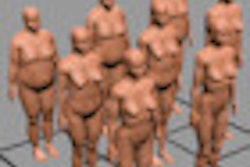Technologists who evaluate the body shape of a child before setting CT exam protocols may be able to further reduce radiation dose, according to a study being presented next week at the 2009 American Roentgen Ray Society (ARRS) meeting in Boston.
The research suggests that manipulation of kVp and mAs based on body shape -- as well as size -- may reduce radiation dose exposure. The study, performed at the Cleveland Clinic Children's Hospital, measured radiation dose of phantoms that were comparable to the average waist sizes of children 2 to 18 years of age.
The lowest acceptable doses were 12 mGy for a 10-cm phantom, 19 mGy for a 16-cm phantom, and 20 mGy for a 32-cm phantom, according to lead authors Dr. Janet Reid, a pediatric radiologist, and Dr. William Davros, section head of medical physics.
Results showed that although dose reduction is easily achieved through manipulation of mAs, it may be preferable to reduce the dose by adjusting kVp, especially when performing iodinated contrast-enhanced scans. These take advantage of a higher k-edge absorption, enhancing the shades of gray at a lower kVp level.
The researchers hope that the findings will enable technologists to tailor a patient's radiation dose to his or her age, weight, and body shape, in essence creating a personalized radiation dose for each child.
Related Reading
NQF report endorses Image Gently campaign, March 30, 2009
Image Gently organizers look ahead on one-year anniversary: Part 1, February 9, 2009
GE launches pediatric CT scanning protocols, January 14, 2009
Study: Radiologists dial back on pediatric CT settings, September 4, 2008
Copyright © 2009 AuntMinnie.com




















